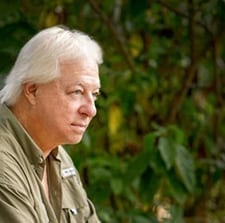Celestial Delights, Weather Folklore, & More
December 5, 2015By Tom Poland

Lunar Halo
Stargazers, here’s an early Christmas gift for you.
A sprinkling of stars salt a sky of cobalt and a feathery ring of light circles a cloud-covered moon. All in all, it’s a portrait of evening transitioning to pitch-black night.
To what do we owe this atmospheric splendor? Let’s start with the moon halo, known, too, as a “glory.” High aloft in the upper atmosphere, six-sided ice crystals refract, reflect, and disperse moonlight. A surreal ring results.
Nothing so dramatic as a ring around the moon can go without meaning. Folklore holds that a moon ring means bad weather is coming, CCR’s bad moon rising. And then there’s this child-like verse. “Ring around the moon means rain soon.” There’s truth behind this saying. Note the feathery cirrus clouds. High cirrus clouds often herald a storm’s arrival.
And what about those infinite celestial luminaries, stars? Blurred ever so little by Earth’s rotation, these lustrous spheres of plasma pierce the blue, punching holes in the night. (Were you to enlarge this image, you’d see countless more.) The oak, yet to be stripped of its leaves, splits the moon asunder.
More common than you think, a lunar halo nonetheless provides us a celestial treat—and a warning.

Cobbled Sky
An autumn day near McBee, a Saturday to be precise. For many, a peach orchard is out of sight and out of mind this time of year, for apples, pumpkins, pecans, and sweet potatoes reign as autumn’s celebrities. Unless we see peach cobbler steaming on the table Thanksgiving Day, we seldom think of peach trees this time of year, but here our eyes feast on the beauty of a sun-glazed autumn orchard.
Do the seams of color in this Pee Dee peach orchard not rival a spring orchard’s soft pink blossoms? Gold-green grass, orange-red trees, and a vein of blue cobble colors across a land soon to feel winter’s icy hand, of which the smudge of gray hints.
The mountains earn accolades for fall splendor, as does a golden saltwater marsh. A blackwater river (the Edisto) reflecting red, yellow, and orange leaves ranks high on the list too. Spring warrants praise, but to many people fall’s palette takes the cake. Consider autumn Earth’s last volley of color before gray skies and darkness rob us of sights such as this one. Winter must come and go before these trees adorn themselves in delicate, pink blossoms, but for now they do just fine.

Bejeweled, Bedeviled, Beloved
Weather Folklore: When dew is on the grass, rain will never come to pass.
Science: When air temperature cools to the dew point, water droplets materialize and frost Muhlenbergia filipes rime-like. Known too as purple muhly grass, you know it as sweetgrass. Most people take no notice of this plant much of the year, but come autumn you can’t miss its pinkish-purple plumes. When the sun backlights this long-stemmed rosy-pink grass, it blazes afire.
Come cool mornings, dew strings crystal beads onto sweetgrass and refashions spiders’ orbs into diamond necklaces—an ephemeral, bejeweled world receives early risers. Let these exquisite, feathery grasses fire up your imagination. Do you see wind-ginned cotton candy? Dreamlike clouds drifting into a rain forest? Chiffon, sheer and silky? Downy breast feathers of a roseate spoonbill? Whatever you conjure up, understand that these plants face adversity.
An Admonition: Sweetgrass grows behind dune lines and along the fringes of marshes and forests. Development and gated communities bedevil the grass. Charleston and Sea Island weavers must go farther afield to find the sweetgrass that, cut into sheaves and coiled and worked with broken spoons, becomes beloved heirloom baskets.
Said a weaver, “Grass getting so hard to find.” Here today. Gone tomorrow.

This photograph appears on page 141, Reflections of South Carolina, Vol. 2, USC Press, 2014
Sandhills Mirage
Things are not always what they seem. An aerial photo of Carolina Sandhills National Wildlife Refuge reveals a raging dust storm. But, no, it’s morning fog.
And from what cometh this silica-rich land? As Ice Age glaciers melted and reformed, the sea rolled in and out. Throughout Earth’s history, climate change has been a constant. Sandy ridges survive from a coastline formed some 20 million years ago during the Miocene. Had you lived in the Sandhills then you might have lived on the beach. We know this because fossils of sea creatures say it’s so.
Here in arid, barren sands live future fossils: the rare and endangered red-cockaded woodpecker, pixie moss, pine barrens treefrogs, and competition aplenty as the refuge supports 190 bird species, 42 mammal species, 25 amphibian species, and too many plant species to count.
And up above? Clouds form easily. Research suggests thunderstorms occur more often in the Sandhills than other provinces. The drier sandy soil bakes beneath a sun of the subtropics and heat ascends. As moisture-heavy winds blow in from the Gulf of Mexico, thunderstorms form. A foggy dream or electric-blue bolts making glass from sand? Denizens of this dry world don’t complain. Both sustain them.
Visit Tom Poland’s website at www.tompoland.net
Email Tom about most anything. [email protected]
Tom Poland is the author of twelve books and more than 1,000 magazine features. A Southern writer, his work has appeared in magazines throughout the South. The University of South Carolina Press has released his and Robert Clark’s book, Reflections Of South Carolina, Vol. II. The History Press of Charleston published his book,Classic Carolina Road Trips From Columbia, and the USC Press just released Georgialina, A Southland As We Knew it. He writes a weekly column for newspapers in Georgia and South Carolina about the South, its people, traditions, lifestyle, and changing culture.
Sign up here to start your free subscription to MidlandsLife!



















